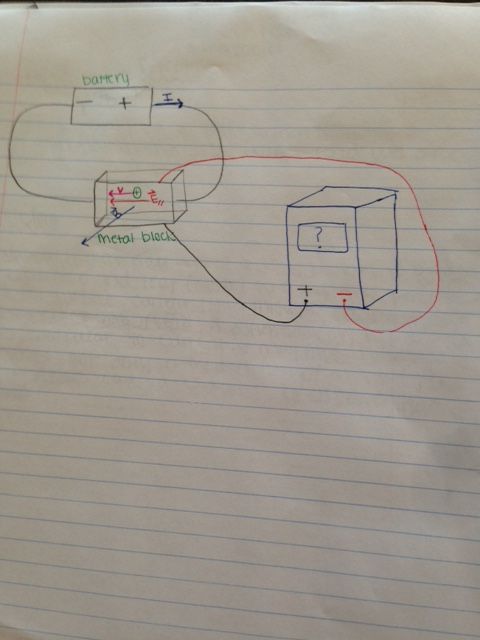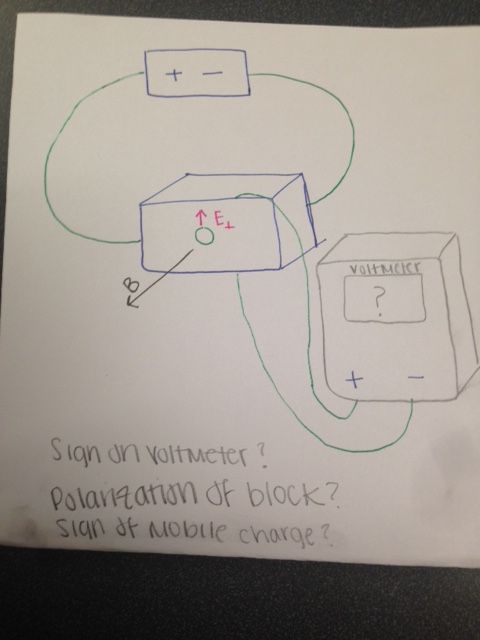Hall Effect
Claimed by Katherine Freesemann
The Hall Effect uses the idea of Fnet being equal and Fnet being the Lorentz Force in these "Hall Effect" questions. This Fnet of zero is achieved due to the polarization properties of metal. Using what we know about how to calculate the Lorentz Force, we can determine things such as the sign of a mobile charge carrier. The Hall Voltage (which is not discussed in this Wiki Page) is a continuation of this idea of the Hall Effect and can be used to determine things such as the density of a mobile charge and can provide more information about the perpendicular electric field. This page is mainly about observations that can be made using Hall Effect without even having to calculate numbers. It is fundamental to understand this page before moving on to calculations with the Hall Effect.
The Main Idea
When a mobile charge flows through a wire or metal block and are also influenced by a magnetic force, the mobile charges begin to build up on one side or the other of the block. Because metals have the unique ability to have very mobile charges (unlike insulators) the block polarizes and has negative charges on one side and positive on the other so that the block is able to remain neutral. This grouping of positive charges in one part of the block and negative charges in another part of the block creates an electric field and thus an electric force perpendicular to the flow of the mobile charges through the wire. The magnetic and electric forces cancel each other out and after some time, the charges flow right through the block and do not group on one side or the other of the block. This perpendicular electric field also creates a potential difference known as the "Hall Voltage."
A Mathematical Model
What are the mathematical equations that allow us to model this topic. [math]\displaystyle{ \vec{F}_{magnetic}= \vec{F}_{electricperpendicular} }[/math] where F_magnetic is the force on the mobile charge by the magnetic field and F_electricperpendicular is the force the mobile charge experiences that is caused by the polarization of the metal.
A Diagram of How the Hall Effect Works
In this diagram, I assumed that the mobile charge carrier was positive.
Examples
The following are 3 examples that help to reinforce the concepts of the Hall Effect. Just like this page, they are all conceptual, so make sure to understand these examples before doing calculation using the Hall effect.
Simple
Question: A metal slab is connected to a battery by two wires. Conventional current flows clockwise and the mobile charge in the block is positive. The block also experiences a magnetic field out of the page. The slab is also connected to a voltmeter.The positive end of the voltmeter is connected to the bottom of the block and the negative end of the voltmeter is connected to the top of the block. See attached photo for a diagram.
Answer: In order to determine this, we must determine what direction the magnetic force is. In this case, since magnetic force is qv X B, the magnetic force points up. This means that the mobile charges (positive) will be pushed towards the top of the block and the negative charge will be at the bottom of the block, so that the block will remain neutrally charged. Remember: a voltmeter will have a positive reading if the positive end is connected to the part with the larger potential. In this case, the larger potential is at the top because that is where the positive charge is, but the negative end of the voltmeter is connected there. The voltmeter will have a negative reading.
Middling
Question: A battery and metal block are connected by 2 wires. Conventional current flows counterclockwise. A voltmeter is attached to the block with its positive lead at the top of the block and its negative lead at the bottom of the block. The voltmeter has a positive reading. What sign does the mobile charge have? (See attached diagram)
Answer: First of all, due to the Voltmeter having a positive reading, we know that the electric field perpendicular (or the electric field that the Voltmeter is telling us about) points from where the positive lead of the voltmeter is connected to the negative lead (in this example, from top to bottom). We also know that Fmagnetic + Felectric_perpendicular equals zero, so F_b and F_e must have opposite signs. F_b is calculated using I*dl X B. The right hand rule tells us that F_b points in the positive y direction. This tells us that F_e perpendicular must point in the negative y direction. F_e is simply (E*q). As determined earlier, E already points in - y direction so we can conclude that the mobile charges are positive.
Difficult
Question: A battery and metal block are connected by two wires. There is also a magnetic field coming out of the page. You are told that the Efield perpendicular is point in the positive y direction. There is also a voltmeter with the positive lead on the top of the block and the negative lead is on the bottom of the block. You are asked to find: the sign of the potential difference that the voltmeter will measure, the polarization of the block, and the sign of the mobile charge. (See attached diagram)
In this case, because F_b is (I*dl) X B, we can say that F_b points in the negative y direction. Since F_b must equal -F_e, F_e must point in the + y direction. E perpendicular does, so this means that our mobile charge is positive (See the previous problem for more explanation of finding the mobile charge). The polarization is determined by analyzing which way the magnetic force (before the Electric force cancels it out) pushes the mobile charge. In this case, the magnetic force pushes the positive mobile charge to the bottom, so negative mobile charges are at the bottom of the block to maintain neutrality. If the positive lead is connected to the place of higher potential (the positive polarization of the block), then the volt meter would read positive. In this case, the positive lead is connected to the place of lower potential, so the voltmeter would be negative.
Connectedness
How is this topic connected to something that you are interested in?
I really enjoy puzzles and I feel as though the Hall Effect is pretty much a large puzzle. You are given a little bit of information and also have several key physics laws and from that you can figure out a lot about a piece of metal.
How is it connected to your major?
Hall effect is all about seeing the relationship between magnetic and electric forces while also remembering how metals polarize. This means that it has a lot of mechanical and machine applications. It can sense when a magnetic field or electric field changes, so it can control many machines, apply pressures, and report many values. All of these skills are very important for Mechanical Engineering, so this topic has a lot of relevence to my major. Also, a lot engineering in general is about analyzing concepts before calculating a lot of values. The idea of the Hall Effect gives a lot of important data without the use of any numbers (of course it gives more info with the calculation of numbers). This reasoning process required for the Hall Effect is a very helpful skill for engineers to have.
Is there an interesting industrial application?
Hall Effects are used in industry to aid in the control of Hydraulic systems such as moving cranes and backhoes. It is also used to help sense a car wheel's motion to aid in the use of anti-skid/anti-lock brakes.
History
The Hall Effect was discovered in 1879 by Edwin Herbert Hall while he was attending Johns Hopkins University for his Doctoral Degree. He exposed a gold leaf (metal slab) to a magnetic field perpendicular to its surface and had current flow through the slab. He observed a potential (delta V) perpendicular to the current and also the magnetic field. This means that potential is observed not only in the direction of current flow like usual. This is what led to Hall's discovery o the Hall Effect.
See also
Are there related topics or categories in this wiki resource for the curious reader to explore? How does this topic fit into that context?
Combining Electric and Magnetic Forces
Further reading
Books, Articles or other print media on this topic
Matter and Interactions: Volume 2 by Ruth Chabay and Bruce Sherwood (4th Edition)
http://www.phys.utk.edu/labs/modphys/Hall%20Effect.pdf
External links
Internet resources on this topic
http://hyperphysics.phy-astr.gsu.edu/hbase/magnetic/hall.html
https://www.youtube.com/watch?v=_ATDraCQtpQ
References
This section contains the the references you used while writing this page
https://en.wikipedia.org/wiki/Hall_effect
http://www.nobelprize.org/nobel_prizes/physics/laureates/1998/press.html
https://en.wikipedia.org/wiki/Edwin_Hall
Matter and Interactions: Volume 2 by Ruth Chabay and Bruce Sherwood (4th Edition)




